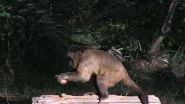(Press-News.org) The vivid pigmentation of zebras, the massive jaws of sharks, the fight or flight instinct and the diverse beaks of Darwin's finches. These and other remarkable features of the world's vertebrates stem from a small group of powerful cells, called neural crest cells, but little is known about their origin.
Now Northwestern University scientists propose a new model for how neural crest cells, and thus vertebrates, arose more than 500 million years ago.
The researchers report that, unlike other early embryonic cells that have their potential progressively restricted as an embryo develops, neural crest cells retain the molecular underpinnings that control pluripotency -- the ability to give rise to all the cell types that make up the body.
"This study provides deep new insights into the evolutionary origins of humans and other vertebrates," said evolutionary molecular biologist Carole LaBonne, who led the research. "It also provides critical new information about the molecular circuitry of stem cells, including cancer stem cells."
Regenerative medicine scientists now have an updated framework for future studies aiming to harness the power of stem cells to treat human diseases and congenital defects, LaBonne said.
The study also turns conventional thought on its head. Previously, scientists thought neural crest cells had to evolve to gain their incredible properties, but the Northwestern work shows the power was there all along. Researchers now can focus on the molecular mechanisms by which neural crest cells escaped having their potential restricted.
In a study using embryos from the frog Xenopus, a powerful model system used in studies of development, LaBonne and her team found that neural crest cells and the early pluripotent cells present in blastula embryos have surprising similarities, including shared expression of a key set of genes which work together to endow the cells with their unique properties.
The findings will be published today (April 30) as a Science Express article by the journal Science. The article also will be the cover story of the journal's June 19 issue.
"Neural crest cells never had their potential restricted at all," LaBonne said. "We believe a small population of early stem cells were set aside, so that when the time came, their immense developmental potential could be unleashed to create new features characteristic of vertebrates."
LaBonne is a professor of molecular biosciences in the Weinberg College of Arts and Sciences. She holds the Arthur Andersen Teaching and Research Chair and is co-leader of the Tumor Invasion and Metastasis program of the Robert H. Lurie Comprehensive Cancer Center of Northwestern University.
Acquisition of neural crest cells more than 500 million years ago led vertebrates to evolve and leave behind less complex life forms (simple aquatic filter feeders, much like today's sea squirts and lancelets). With these cells, animals developed important new features such as a skull to house a complex brain, jaws for predation, a complex peripheral nervous system and many other cell types essential to the vertebrate body.
In their study, LaBonne and her research team studied the genetic toolkit that early embryonic cells use to promote pluripotency or "stemness" and compared it to the one used by neural crest cells. They found that the toolkit used by neural crest cells also is used by pluripotent blastula cells, and they showed that it is essential for pluripotency in both cell types. The proteins that derive from this toolkit work together to enable a dizzying array of tissues to arise from a population of single cells.
One of these proteins, called Snail1, has been the focus of previous studies by LaBonne's lab. They and others had shown that Snail1 plays key roles in controlling not only the immense developmental potential of neural crest cells but also their capacity for migratory and invasive behavior.
Cancer cells co-opt the function of Snail1 and other neural crest regulatory proteins to allow the formation of cancer stem cells and mediate the process of metastasis, whereby cancer cells disperse throughout the body to form new tumors, LaBonne said. Researchers therefore gain insights into Snail1's role in cancer by studying its function in the developing embryo.
In early blastula embryos, pluripotent cells were thought to exist only transiently; as an embryo develops, cells become restricted into categories of cells called germ layers and then into specialized cell types. The Northwestern study suggests that not all cells get restricted at those early stages. Instead, neural crest cells may have evolved as a consequence of a subset of blastula cells retaining activity of the regulatory network underlying pluripotency.
The study underscores just how much remains to be discovered about embryonic development. The human body has more than 10 trillion cells elaborately organized into tissues and organs that are intricate and highly complex, yet it all is self-assembled from a single cell, the fertilized egg.
"It's a fascinating process," LaBonne said. "One of the great frontiers in biology is understanding both how complexity is generated and how it evolves to create what Charles Darwin memorably called 'endless forms most beautiful.'"
INFORMATION:
The title of the paper is "Shared Regulatory Programs Suggest Retention of Blastula-Stage Potential in Neural Crest Cells."
In addition to LaBonne, other authors of the paper are Elsy Buitrago-Delgado, Kara Nordin, Anjali Rao and Lauren Geary, all Ph.D. students in Northwestern's Interdisciplinary Biological Sciences Program, directed by LaBonne.
ORANGE, Calif. - Researchers in Chapman University's Argyros School of Business and Economics and their collaborators have just published a study on the evolution of yoga in the marketplace. Assistant Professor Gokcen Coskuner-Balli, Ph.D., co-authored the study, which examined how the meaning of yoga transformed in the past three decades. The results show that yoga became decreasingly associated with spirituality and increasingly associated with medicine and fitness. The study argues that the shift in the meanings are due to the changes in how yoga gurus are trained, market ...
Flowering plants, also known as angiosperms, add an allure to the world that is unlike anything else in nature, but more importantly, they sustain us. Most of the fruits, vegetables, grains, beans, nuts, and even herbs and spices that we consume are produced by flowering plants. They all belong to the green plant branch of the tree of life, and a novel DNA analysis software program named MarkerMiner facilitates identification of genes that can be used to elucidate the evolutionary relationships between them.
University of Florida (UF) biologist Srikar Chamala, working ...
Over the past 35 years, California's high-wage workers have seen steady increases in their paychecks. But low-wage workers, 4.8 million strong and about one-third of the state's workforce, earned less in inflation-adjusted dollars in 2014 than they did in 1979, according to an analysis from the University of California, Berkeley.
UC Berkeley researchers analyzing U.S. Census Bureau data at the campus's Center for Labor Research and Education found that low-wage workers, defined as those earning hourly wages of $13.63 or less, have seen steady declines in their inflation-adjusted ...
As the number of bills passed by Congress declines, fewer and fewer Congressional representatives are voting across party lines, leaving only a few key representatives as collaborative voters, according to researchers.
"We can't say for sure that the decline in cooperation is the sole reason that there are fewer bills being introduced or passed by Congress, but we do know the two are statistically correlated, and both have been dropping steadily over the past 60 years," said Clio Andris, lead author and assistant professor of geography at Penn State.
The researchers ...
China's government and other sources say that the country's carbon-dioxide emissions flattened out between 2013 and 2014. The leveling-off was a remarkable feat that could set the country on a course to beating its own goals for lowering emissions. But this optimistic outcome hinges on China overcoming some serious energy challenges, according to an article in Chemical & Engineering News (C&EN), the weekly newsmagazine of the American Chemical Society.
Steven Gibb, a senior editor at C&EN, reports that a number of factors could help explain the emissions plateau. China ...
How and when does mom feed her embryo? We humans, like most mammals, experience pregnancy where a mother supplies nutrition directly to the embryo as it develops. But we're in the minority.
Most members of the animal kingdom supply eggs with nutritious yolk before they are fertilized. With this yolk supply, fertilized eggs develop as embryos in the environment outside the mother's body. For over a century, the scientific understanding of matrotrophy ("mother-feeding") of an embryo developing inside a mom's body has come from vertebrate animals, especially mammals like ...
The latest Special Issue from ecancermedicalscience is dedicated to the memory of our late friend, Dr Mario Sideri.
The Special Issue, "Prevention of gynaecological cancers: in memory of Mario Sideri," consists of nine articles centred around Dr Sideri's favoured research topic.
Dr Sideri was one of the first doctors in the world to identify the connection between the human papillomavirus (HPV) and cervical cancer.
He served as the Director of the Preventive Gynecology Unit at the European Institute of Oncology (IEO) in Milan from 1994 until his tragic death in June ...
When it comes to cracking nuts, wild bearded capuchin monkeys are more skilled than anyone had given them credit for, according to researchers who report new findings in the Cell Press journal Current Biology on April 30.
The monkeys are known to use stone "hammers" to crack nuts. The new study shows that the monkeys are quite careful about the amount of force delivered to those nuts. They adjust the force applied with each strike based on the condition of the nutshell, making it less likely that they'll end up smashing the tasty kernel inside.
"Wild bearded capuchin ...
Bats are masters of flight in the night sky, capable of steep nosedives and sharp turns that put our best aircraft to shame. Although the role of echolocation in bats' impressive midair maneuvering has been extensively studied, the contribution of touch has been largely overlooked. A study published April 30 in Cell Reports shows, for the first time, that a unique array of sensory receptors in the wing provides feedback to a bat during flight. The findings also suggest that neurons in the bat brain respond to incoming airflow and touch signals, triggering rapid adjustments ...
Neuroscientists have perfected a chemical-genetic remote control for brain circuitry and behavior. This evolving technology can now sequentially switch the same neurons - and the behaviors they mediate - on-and-off in mice, say researchers funded by the National Institutes of Health. Such bidirectional control is pivotal for decoding the brain workings of complex behaviors. The findings are the first to be published from the first wave of NIH grants awarded last fall under the BRAIN Initiative.
"With its new push-pull control, this tool sharpens the cutting edge of ...

